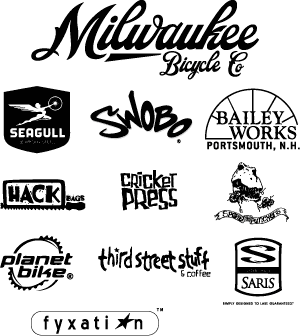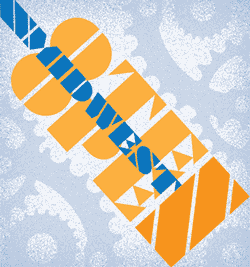EQUIPMENT
1 - Teams will consist of three players on the court at one time.
2 - Any common type of bike is allowed. (BMX, road, track, mountain)
2.1 - The bike must have at least one mechanism for stopping. (i.e., handbrake, fixed wheel)
2.2 - No bullhorn-style handlebars.
2.3 - You may not add anything to the bike to help block shots (e.g., a bar under your BB, netting in the front triangle) with the exception of wheel covers.
2.4 - Mallets and bikes may not have dangerous protrusions (bolts sticking out, jagged edges, etc.) Handlebars must be capped. Mallet shaft ends must also be capped.
2.5 - Helmets are mandatory. Pads are recommended.
GENERAL RULES OF PLAY
3 - Start of a game:
3.1 - Each team will begin behind his/her own goal line.
3.2 - The ball will be positioned at center court.
3.3 - Play will begin with a “3 - 2 - 1 - Go” from the timekeeper.
4 - Scoring a goal and ball movement:
4.1 - A goal must originate as a “shot,” defined as striking the ball with the end of the players mallet.
4.2 - Wrist shots or scoop shots are not considered a “shot,” therefore will not count as a goal. This technique may be used to pass the ball.
4.3 - A “shuffle,” defined as a ball that is struck with the broad side of the mallet, will never count as a goal unless the ball is
shuffled by a player into their own net. This is an own goal. If an offensive player shuffles the the ball into their opponents it will not count. The defending team will get possession of the ball and the offensive team will concede half-court.
4.4 - Ball-joint: Not to be confused with a scoop pass, toss or other ball handling. The ball-joint is defined as pinning the ball
between an open end of the mallet head and the playing surface and then dragging it. Ball-jointing will be allowed ONLY in the player’s defensive zone. Ball jointing in the offensive zone will result in the ball turnover and concession of half-court.
4.5 - If the ball becomes lodged on a player, bicycle or in the spokes of a wheel in such a way that it cannot be played safely,
game play will be stopped. The ball will be dislodged and placed on the ground at the point of incident. The player directly involved in the ball being lodged will get possession and play will resume.
4.6 - The ball cannot be played with the feet. Intentionally touching the ball will be counted as a foot-down or “dab” (see below) and that player will be required to tap-out.
5 - After a goal is scored:
5.1 - The scoring team returns to their half of the court.
5.2 - The conceding team gets possession of the ball.
5.3 - Play will not resume until both teams have returned to their half of court.
5.4 - The defending team may not attack until the ball or an offensive player has crossed half court.
6 - Footdown or “Dab”:
6.1 - A foot-down or “dab” is defined as any player placing their foot on any horizontal surface (e.g., the ground, his mallethead, a bike, the ball, another player.)
6.2 - If a player “dabs” that player is out of play and may not interfere with the ball or other players until they “tap in” at one of two designated center court points.
6.3 - If a “dabbed” player stops a shot from going into the net, at the ref’s discretion, it may be ruled a goal. Example: a defending player in front of the net loses their balance and dabs. The defending playernremains in front of the net - intentionally or unintentionally - and blocks an incoming shot. If there is no doubt in the referee’s mind that the shot would have resulted in a goal, the referee can declare a goal. If it is also determined that the defending player intentionally blocked the net when out of play they will be awarded a two-minute penalty.
6.4 - The “tap-in” area will be located along the center court line; on either side of the court. There are 2 tap-in areas per court.
6.5 - If a player crashes or falls off their bike, play will continue unless a player is injured. At this point the referee will stop the game and attend to the injured player.
CONTACT AND GENERAL COURT BEHAVIOR
Like contact between bodies and equipment is permitted. However, depending on the severity, any physical, mallet or bike play
that is considered by the referee to be excessive, reckless and potentially dangerous to the safety of the players will result in a
warning or a penalty. Essentially, the choice to check/pick/mallet-to-mallet is not the issue. It’s how you do it.
7 - Permitted contact and restrictions:
7.1 - body-to-body - this includes shoulder-to-shoulder contact and the use of forearms.
7.2 - mallet-to-mallet - this includes incidental contact playing the ball and lifting another player’s mallet. Striking another player’s mallet with excessive force, or slashing, will result in a warning or a penalty.
7.3 - Holding or otherwise restraining another player by grabbing that player, their clothing or any of their equipment using hands, elbows, feet or mallets is not permitted.
7.4 - Pushing with the hands is not permitted.
7.5 - Pushing or checking someone from behind is not permitted.
7.5 - Mallet-to-body contact is not permitted.
7.6 - Mallet-to-bike contact is not permitted.
7.7 - Body-to-bike contact is not permitted.
7.8 - Incidental bike-to-bike contact is fine. Throwing a rear wheel into another player’s bike and T-boning is not permitted.
7.9 - Any check along the side boards - in this case, boards two feet high or lower - that results in the opposing player going over the boards will be heavily scrutinized. If the check is deemed appropriate and the opposing player simply could not maintain their balance, play will continue. If, however, the check against the boards is deemed excessive, reckless or otherwise thought to have little regard for the safety of the opposing player, the referee has the option to issue a warning or a penalty.
7.10 - Clear intent to injure another player is not permitted and will be met with a severe penalty.
7.11 - Throwing of mallets is not allowed at any time, in any situation. Intentionally throwing a mallet will automatically result in at least a 30-second penalty.
7.12 - If a thrown mallet stops a ball from going through the goal the referee may use his discretion to award a goal.
TIME-OUTS
The referee reserves the right to stop game play for any reason. Time-outs will/can be called for the following reasons:
* A goal is scored. A time-out can be called for a mechanical, or water, etc.
* The ball goes out of play. The game will be paused until the ball can be retrieved. The defending team will then get possessionof the ball and play will resume.
* Mechanical problem. The team with the mechanical problem may request a timeout only after they take possession of the ball.
* Serious injury.
|




